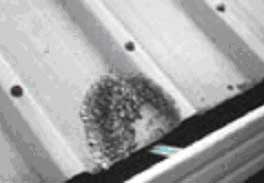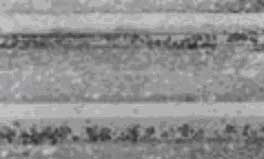Mild Steel
Defect and Repair
|
Mild Steel |
Defect
|
Repair
|
 |
Fungal Growth
Fungal growth, can occur on virtually all surfaces when the “micro-environment” on and around a particular installation is conducive to it. In general, it is believed that fungi can grow as a result of suitable conditions, such as the presence of fungal spores, moisture and nutrients from “dirt” of various types.
|
If fungus is suspected, it is recommended that a spot test with sodium hypochlorite solution be carried out for identification purposes. The most convenient source of sodium hypochlorite is household bleach. The bleach should be as fresh as possible and the hypochlorite/available chlorine concentration should preferably be above 3%. Care should be taken in handling the solution (i.e. wear the appropriate safey equipment-safety glasses, protective gloves etc), which is quite alkaline. Any tested areas should be thoroughly rinsed with fresh water afterwards.
The test procedure is to apply a drop of the bleach solution to a suspected area, mark the extent of the drop (unobtrusively) and wait a few minutes. If fungus is present, the dark material will be destroyed by the bleach and a clean drop area will result. Please note this is not a foolproof test for identifying fungus as the bleach can also affect organisms such as algae and bleachable organic matter. However, it is a valuable test as it will distinguish between fungus and normal inorganic dirt, which will not be bleached. |
 |
Lichen
Lichen is a growth incorporating both fungus and algae. Its appearance on a prepainted roof, as illustrated, is quite distinctive.
|
|
 |
Chip Off of Paint
|
The defective panel/ extrusion should be brought to a good state of repair before repainting is done. The original coating that has low adhesion to the substrate should be removed using a sharpened paint scrapper or hydoblasting technique.
Paint is then applied over the substrate evenly with particular attention given to achieving a good standard of finish. |
Notes: To restore a roof affected by fungus, it is recommended that the roof be washed down with a 2% sodium hypochlorite solution. The sodium hypochlorite solution can be made up from commercially available bleaches.
To assist in making up the solution, table below shows the dilution required for different strength bleaches to give a 2% solution. The bleach should be applied with a soft bristle broom, left for 3-5 minutes, and washed off with copious amounts of water. A small amount of household detergent may be added to the bleach if necessary to improve wetting.
Important – If you collect rainwater from your roof, it is recommended the line between your gutters and the collection tank be disconnected before commencing cleaning to avoid contamination of the water supply.
|
% Sodium hypochlorite or % available chlorine in bleach (by weight) (NB: 10g/L = 1%)
|
Dilution to give 1L of 2% sodium hypochlorite solution
|
|
10%
|
200mL bleach + 100mL water |
|
5%
|
400mL bleach + 600 mL water |
|
4%
|
500mL bleach + 500mL water |
|
3%
|
670mL bleach + 330mL water |
|
2%
|
No dilution required |
For more defects, please refer to the Defect Library.